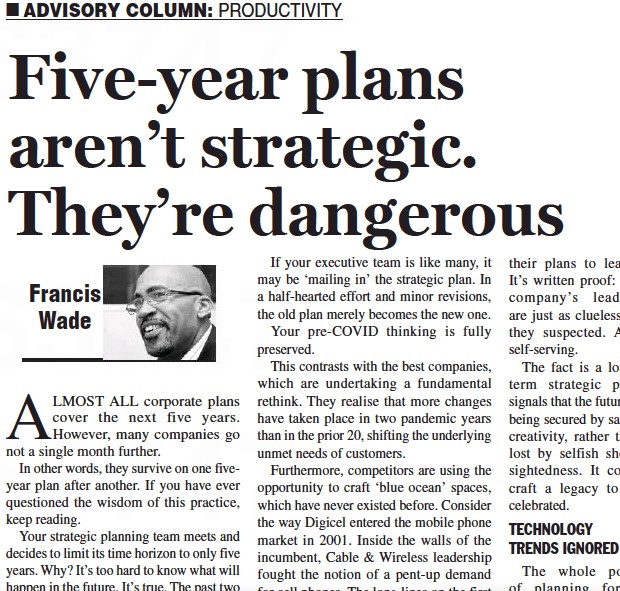Almost all corporate plans cover the next five years. However, many companies go not a single month further. In other words, they survive on one five-year plan after another. If you have ever questioned the wisdom of this practice, keep reading.
Your strategic planning team meets and decides to limit its time horizon to only five years. Why? “It’s too hard to know what will happen in the future.” It’s true. The past two years have brought COVID, the recession, a war and other rude surprises. Companies’ best intentions lay in tatters.
Given the amount of change we have experienced, some say it’s folly to think past the short-term. In their mind, leaders will be so wrong about the future that it makes no sense to think too far out. The idea seems perilous.
If your managers are thinking along these lines, they aren’t alone. Around the world, the focus of attention has been on survival tactics. They keep the top line viable, limit costs, micro-manage workers performing their duties and secure supply chains.
Why then, should your company consider the creation of a new long-term plan? Here are three reasons we have gleaned in two decades of experience with clients who craft 15-30 year plans.
= Your 5-Year Plan is Just a Dull Revision
If your executive team is like many, it may be “mailing in” the strategic plan. In a half-hearted effort and minor revisions, the old plan merely becomes the new one.
Your Pre-COVID thinking is fully preserved.
This contrasts with the best companies, which are undertaking a fundamental re-think. They realize that more changes have taken place in two pandemic years than in the prior 20, shifting the underlying unmet needs of customers.
Furthermore, competitors are using the opportunity to craft “Blue Ocean” spaces which have never existed before. Consider the way Digicel entered the mobile phone market in 2001. Inside the walls of the incumbent, C&W leadership fought the notion of a pent-up demand for cell phones. The long lines on the first day of free competition propelled the new entrant to regional prominence.
If your company is too busy or lacks the energy to do a rethink, prepare for its own rude surprise.
= Your 5-Year Plan is For You, Not Them
While the Great Resignation is slow to reach the Caribbean, this hasn’t stopped the Big Disengagement. Your most talented and accomplished employees are withholding discretionary effort, searching for outside opportunities, and starting side-hustles in the meantime. Their faces are on the screen, but their dreams lie elsewhere.
However, when you announce a fresh strategy, their ears perk up. They want to see whether or not there is something worth staying around for.
Unfortunately, if all they hear is a “new” five-year plan, they will accelerate their plans to leave. It’s written proof: the company’s leaders are just as clueless as they suspected. And self-serving.
The fact is, a long-term strategic plan signals that the future is being secured by savvy creativity, rather than lost by selfish short-sight. It could craft a legacy to be celebrated.
= Your 5-Year Plan Ignores Technology Trends
The whole point of planning for a long horizon is to place intelligent bets now that shape the future. Understanding technology trends helps you do so effectively.
In your industry, these transformations have probably accelerated due to COVID. Companies who have accepted this fact and planned accordingly, are thriving. By contrast, the laggards are stuck teaching their employees how to use Excel and PowerPoint in face-to-face classrooms. They already failed. Perhaps they believed that the digital future would take care of itself.
Today, you know the truth. Organizations which fail to invest in younger, digitally savvy talent will reap the sour fruit of stale thinking. Their strategies won’t disrupt their industries.
This isn’t to say that it’s easy to create a 30-year strategic plan. However, some believe it can be captured in a nebulous vision statement.
Unfortunately, in today’s fast-moving world, these pronouncements arouse the suspicion of staff. Fancy words aren’t enough. Without a roadmap, they simply won’t trust grandiose statements which have no foundation.
To carve a credible route, adopt tools like back casting and the Merlin Process to connect the future to today. Yes…people want Big Hairy Audacious Goals (BHAG’s), but they must be grounded in feasible logic.
The timing may be right for you to create more than a mere five-year plan. It could exploit opportunities which, perhaps for a limited time, beckon your organization to achieve great things. It’s the best way to stay out of danger.
Francis Wade is the author of Perfect Time-Based Productivity, a keynote speaker and a management consultant. To search his prior columns on productivity, strategy, engagement and business processes, send email to columns@fwconsulting.com.

